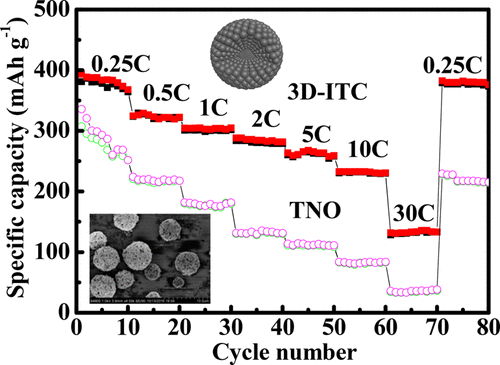当前位置:
X-MOL 学术
›
ACS Appl. Mater. Interfaces
›
论文详情
Our official English website, www.x-mol.net, welcomes your
feedback! (Note: you will need to create a separate account there.)
Nanoporous TiNb2O7/C Composite Microspheres with Three-Dimensional Conductive Network for Long-Cycle-Life and High-Rate-Capability Anode Materials for Lithium-Ion Batteries
ACS Applied Materials & Interfaces ( IF 8.3 ) Pub Date : 2017-11-15 00:00:00 , DOI: 10.1021/acsami.7b13246 Guozhen Zhu 1 , Qing Li 1 , Yunhao Zhao 1 , Renchao Che 1
ACS Applied Materials & Interfaces ( IF 8.3 ) Pub Date : 2017-11-15 00:00:00 , DOI: 10.1021/acsami.7b13246 Guozhen Zhu 1 , Qing Li 1 , Yunhao Zhao 1 , Renchao Che 1
Affiliation

|
On the basis of the advantages of ideal cycling stability, high discharge voltage (1.65 V), and excellent reversibility, more and more attention has been focused on TiNb2O7 (marked as TNO) as an anode material candidate for lithium-ion batteries. However, the poor electronic conductivity and low ionic diffusion rate intrinsically restrict its practical use. Herein, we first synthesize the TNO/C composite microspheres with three-dimensionally (marked as 3D) electro-conductive carbon network and abundant nanoporous structure by a simple spray-drying method. The microspheres are constructed by irregularly primary cubic nanoparticle units with size of 100–200 nm. The nanopores throughout the microspheres range from 1 to 50 nm. As an anode material, the prepared TNO/C composite microspheres demonstrate a prominent charge/discharge capacity of 323.2/326 mA h g–1 after 300 cycles at 0.25 C (1 C = 388 mA g–1) and 259.9/262.5 mA h g–1 after 1000 long cycles at a high current density of 5 C, revealing the ideal reversible capacity and long cycling life. Meanwhile, the TNO/C composite microspheres present ideal rate performance, showing the discharge capacity of 120 mA h g–1 at 30 C after 10 cycles. The super electrochemical performance could be attributed to the 3D electro-conductive carbon network and nanoporous structure. The nanopores facilitate the permeation of electrolyte into the intercontacting regions of the anode materials. Carbon layers disperse uniformly throughout the 3D microspheres, effectively improving the electrical conductivity of the electrode. Hence, the prepared TNO/C composite microspheres have great potential to be used as an anode material for lithium-ion batteries.
中文翻译:

具有三维导电网络的纳米多孔TiNb 2 O 7 / C复合微球,用于锂离子电池的长循环寿命和高速率阳极材料
基于理想的循环稳定性,高放电电压(1.65 V)和出色的可逆性的优势,TiNb 2 O 7越来越受到关注(标记为TNO)作为锂离子电池的负极候选材料。然而,差的电子电导率和低的离子扩散速率本质上限制了其实际应用。在这里,我们首先通过简单的喷雾干燥法合成具有三维(标记为3D)导电碳网络和丰富的纳米孔结构的TNO / C复合微球。微球是由大小为100–200 nm的不规则初级立方纳米粒子单元构成的。整个微球的纳米孔范围为1至50 nm。作为阳极材料,制得的TNO / C复合微球表现出323.2 /326毫安Hg的突出充电/放电容量-1 0.25 C(1 C =388毫安克300次循环之后-1)和259.9 /262.5毫安汞- 1个在5 C的高电流密度下经过1000个长时间循环后,显示出理想的可逆容量和较长的循环寿命。同时,TNO / C复合微球具有理想的速率性能,在10个循环后,在30 C时显示出120 mA hg –1的放电容量。超级电化学性能可归因于3D导电碳网络和纳米孔结构。纳米孔促进电解质渗透到阳极材料的相互接触区域中。碳层均匀地分散在整个3D微球中,有效地改善了电极的电导率。因此,制备的TNO / C复合微球具有很大的潜力,可以用作锂离子电池的负极材料。
更新日期:2017-11-16
中文翻译:

具有三维导电网络的纳米多孔TiNb 2 O 7 / C复合微球,用于锂离子电池的长循环寿命和高速率阳极材料
基于理想的循环稳定性,高放电电压(1.65 V)和出色的可逆性的优势,TiNb 2 O 7越来越受到关注(标记为TNO)作为锂离子电池的负极候选材料。然而,差的电子电导率和低的离子扩散速率本质上限制了其实际应用。在这里,我们首先通过简单的喷雾干燥法合成具有三维(标记为3D)导电碳网络和丰富的纳米孔结构的TNO / C复合微球。微球是由大小为100–200 nm的不规则初级立方纳米粒子单元构成的。整个微球的纳米孔范围为1至50 nm。作为阳极材料,制得的TNO / C复合微球表现出323.2 /326毫安Hg的突出充电/放电容量-1 0.25 C(1 C =388毫安克300次循环之后-1)和259.9 /262.5毫安汞- 1个在5 C的高电流密度下经过1000个长时间循环后,显示出理想的可逆容量和较长的循环寿命。同时,TNO / C复合微球具有理想的速率性能,在10个循环后,在30 C时显示出120 mA hg –1的放电容量。超级电化学性能可归因于3D导电碳网络和纳米孔结构。纳米孔促进电解质渗透到阳极材料的相互接触区域中。碳层均匀地分散在整个3D微球中,有效地改善了电极的电导率。因此,制备的TNO / C复合微球具有很大的潜力,可以用作锂离子电池的负极材料。











































 京公网安备 11010802027423号
京公网安备 11010802027423号